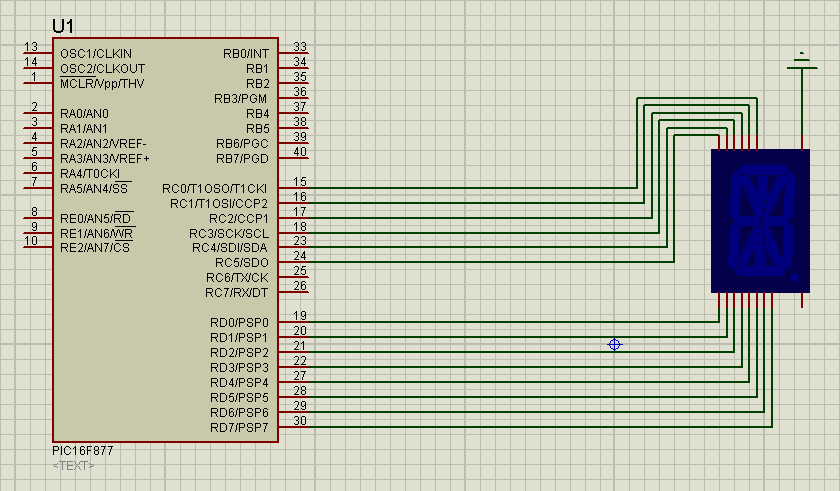Rating:
In the challenge we get a hex file and a schematic:

From the picture we can read the chip name, and thanks to that we can load it into ghidra and specify the architecture to PIC16fF.
There is not much code there really. Main function is:
DAT_DATA_0024 = param_1;
while( true ) {
DAT_DATA_0020 = FUN_CODE_0f00(DAT_DATA_0024);
DAT_DATA_0025 = DAT_DATA_0020;
FUN_CODE_0016();
FUN_CODE_000e();
if (DAT_DATA_0025 == '\0') break;
DAT_DATA_0024 = DAT_DATA_0024 + '\x01';
}
return DAT_DATA_0025;
param_1 starts with 0 and this is just a simple while loop, looping until FUN_CODE_0f00 does not return 0, and incrementing the counter each time -> DAT_DATA_0024 = DAT_DATA_0024 + '\x01'
There are also functions FUN_CODE_0016 and FUN_CODE_000e.
The latter seems to be some kind of active sleep, and the former we actually totally skipped during this challenge and got back to it only for the next one.
What it does, is translating the input value into 14-segment display control code, but we don't really need to know that here.
Going back to FUN_CODE_0f00, this function is:
//
// CODE
// Generated by Intel Hex
// CODE: CODE:0f00-CODE:0f1d.1
//
*************************************************************
* FUNCTION
*************************************************************
undefined FUN_CODE_0f00 ()
assume PCLATH = 0xf
undefined W:1 <RETURN>
FUN_CODE_0f00 XREF[1]: FUN_CODE_0176:017a (c)
CODE:0f00 82 07 ADDWF PC,f
LAB_CODE_0f01 XREF[1]: CODE:0f00 (j)
CODE:0f01 0a 34 RETLW #0xa
LAB_CODE_0f02 XREF[1]: CODE:0f00 (j)
CODE:0f02 0e 34 RETLW #0xe
LAB_CODE_0f03 XREF[1]: CODE:0f00 (j)
CODE:0f03 1b 34 RETLW #0x1b
LAB_CODE_0f04 XREF[1]: CODE:0f00 (j)
CODE:0f04 18 34 RETLW #0x18
LAB_CODE_0f05 XREF[1]: CODE:0f00 (j)
CODE:0f05 24 34 RETLW #0x24
LAB_CODE_0f06 XREF[1]: CODE:0f00 (j)
CODE:0f06 19 34 RETLW #0x19
LAB_CODE_0f07 XREF[1]: CODE:0f00 (j)
CODE:0f07 12 34 RETLW #0x12
LAB_CODE_0f08 XREF[1]: CODE:0f00 (j)
CODE:0f08 0c 34 RETLW #0xc
LAB_CODE_0f09 XREF[1]: CODE:0f00 (j)
CODE:0f09 26 34 RETLW #0x26
LAB_CODE_0f0a XREF[1]: CODE:0f00 (j)
CODE:0f0a 12 34 RETLW #0x12
LAB_CODE_0f0b XREF[1]: CODE:0f00 (j)
CODE:0f0b 1c 34 RETLW #0x1c
LAB_CODE_0f0c XREF[1]: CODE:0f00 (j)
CODE:0f0c 26 34 RETLW #0x26
LAB_CODE_0f0d XREF[1]: CODE:0f00 (j)
CODE:0f0d 1c 34 RETLW #0x1c
LAB_CODE_0f0e XREF[1]: CODE:0f00 (j)
CODE:0f0e 12 34 RETLW #0x12
LAB_CODE_0f0f XREF[1]: CODE:0f00 (j)
CODE:0f0f 16 34 RETLW #0x16
LAB_CODE_0f10 XREF[1]: CODE:0f00 (j)
CODE:0f10 19 34 RETLW #0x19
LAB_CODE_0f11 XREF[1]: CODE:0f00 (j)
CODE:0f11 15 34 RETLW #0x15
LAB_CODE_0f12 XREF[1]: CODE:0f00 (j)
CODE:0f12 0e 34 RETLW #0xe
LAB_CODE_0f13 XREF[1]: CODE:0f00 (j)
CODE:0f13 26 34 RETLW #0x26
LAB_CODE_0f14 XREF[1]: CODE:0f00 (j)
CODE:0f14 1a 34 RETLW #0x1a
LAB_CODE_0f15 XREF[1]: CODE:0f00 (j)
CODE:0f15 04 34 RETLW #0x4
LAB_CODE_0f16 XREF[1]: CODE:0f00 (j)
CODE:0f16 0a 34 RETLW #0xa
LAB_CODE_0f17 XREF[1]: CODE:0f00 (j)
CODE:0f17 08 34 RETLW #0x8
LAB_CODE_0f18 XREF[1]: CODE:0f00 (j)
CODE:0f18 14 34 RETLW #0x14
LAB_CODE_0f19 XREF[1]: CODE:0f00 (j)
CODE:0f19 01 34 RETLW #0x1
LAB_CODE_0f1a XREF[1]: CODE:0f00 (j)
CODE:0f1a 15 34 RETLW #0x15
LAB_CODE_0f1b XREF[1]: CODE:0f00 (j)
CODE:0f1b 07 34 RETLW #0x7
LAB_CODE_0f1c XREF[1]: CODE:0f00 (j)
CODE:0f1c 25 34 RETLW #0x25
LAB_CODE_0f1d XREF[1]: CODE:0f00 (j)
CODE:0f1d 00 34 RETLW #0x0
So it just jumps k bytes forward (where k is the parameter), and each instruction it an hit is just a return with some value.
This means it's a simple mapping x->y.
We know that input for this functio is just consecutive numbers starting at 0, and we can see that it will return 0 for 0x1d and this will break the main loop.
We can therefore just generate the output sequence of this function, but grepping the #0x values:
['0xa', '0xe', '0x1b', '0x18', '0x24', '0x19', '0x12', '0xc', '0x26', '0x12', '0x1c', '0x26', '0x1c', '0x12', '0x16', '0x19', '0x15', '0xe', '0x26', '0x1a', '0x4', '0xa', '0x8', '0x14', '0x1', '0x15', '0x7', '0x25', '0x0']
Now maybe we could have figured out that the FUN_CODE_0016 maps this into 14-segment display, but instead we noticed that the values here start with 0xa 0xe -> ae, looking like flag prefix!
Sadly the first attempt at converting this directly into ASCII failed:
print("".join([chr(int(byte, 16)-0xa+ord('A')) for byte in data]))
But it gave us almost a flag AERO[PIC]IS]SIMPLE]Q;A?K8L>\7.
Clearly the idea is sound, just some detail is wrong.
After a while we figured that maybe it's not ASCII mapping, but something else, and we guessed instead mapping = "0123456789ABCDEFGHIJKLMNOPQRSTUVWXYZ{}_".
Now applying this mapping:
mapping = "0123456789ABCDEFGHIJKLMNOPQRSTUVWXYZ{}_"
print("".join([mapping[(int(byte, 16))] for byte in data]))
Gave us AERO{PIC_IS_SIMPLE_Q4A8K1L7}0